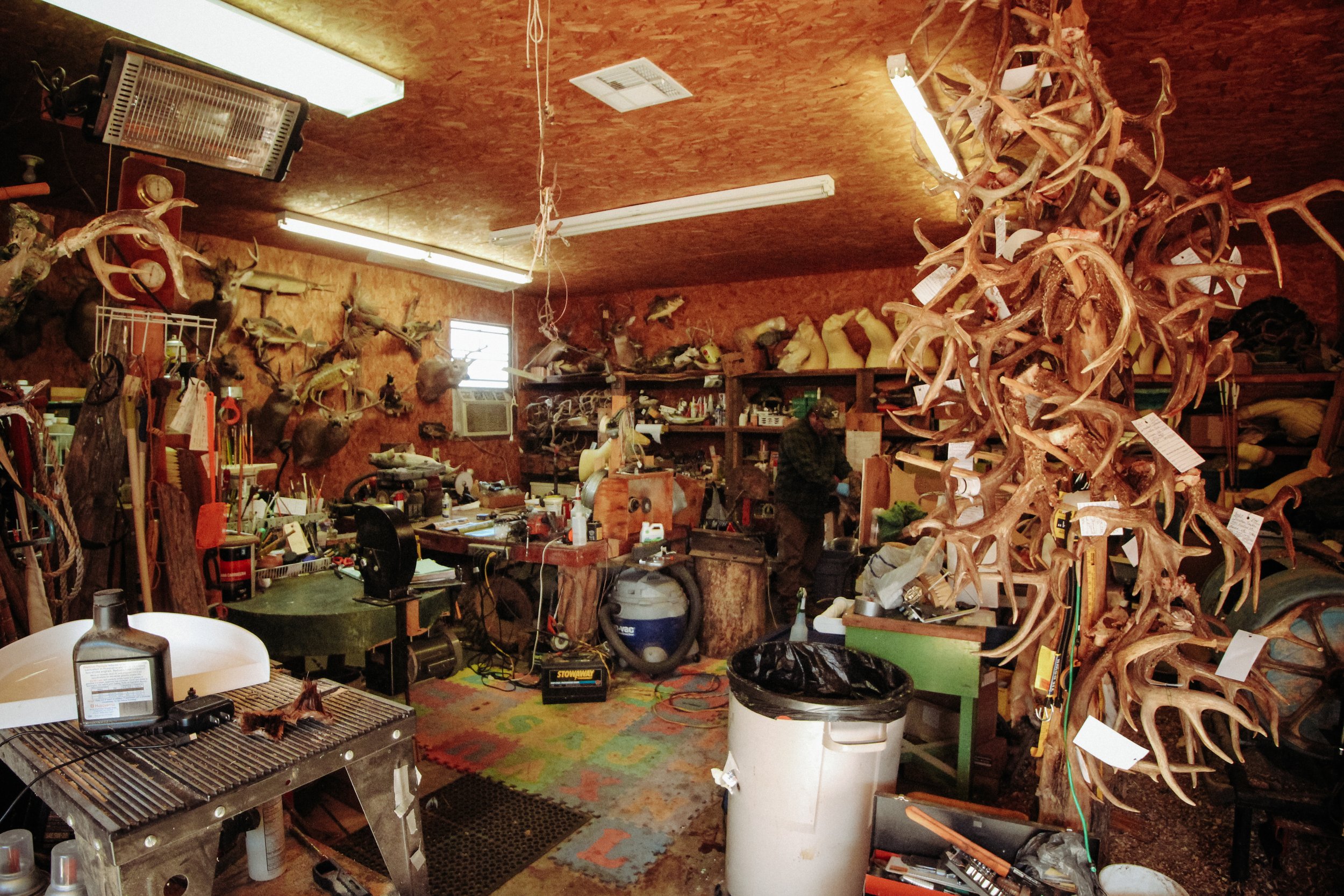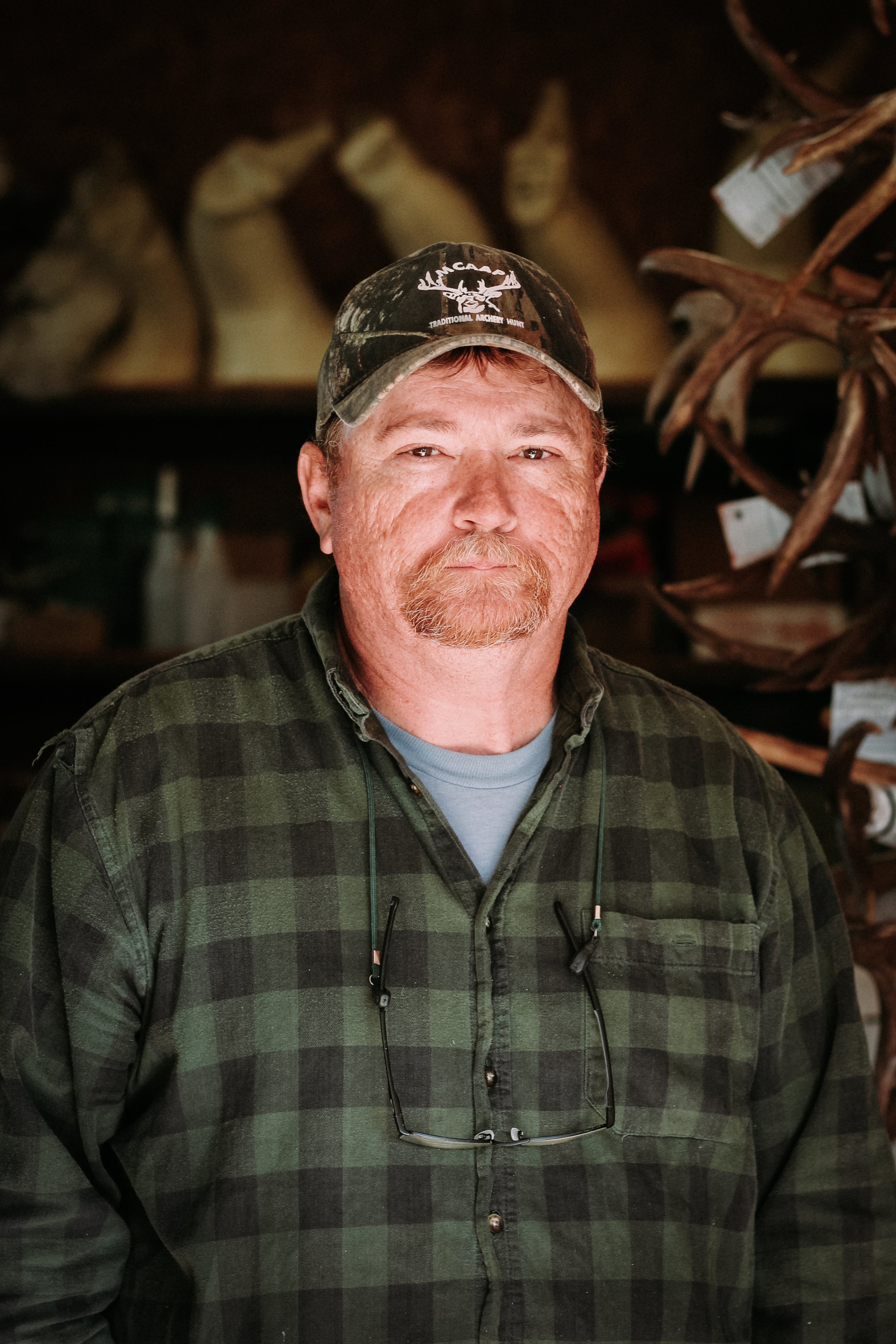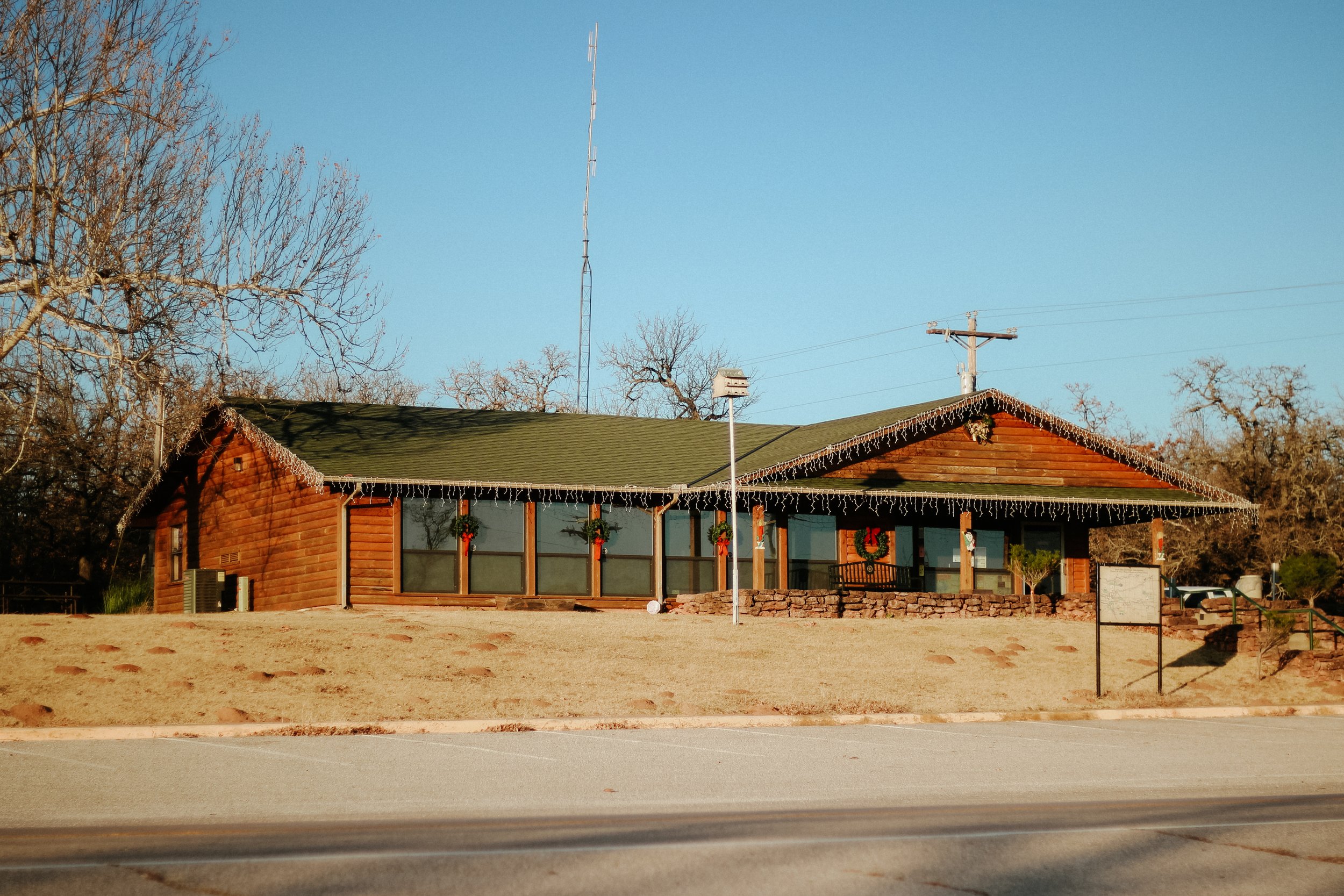
Skinnin’ the Game
Norman, Oklahoma
December 11, 2017 | Photos and words by Megan Ross
Sherman’s garage workshop smells like blood, stale flesh and chemicals. Dozens of glass eyes watch me walk in.
He’s talking to a middle-aged couple who came to drop off a twelve point rack and put a $300 cash down payment on the mount. He pauses his conversation with them to greet me with his friendly Oklahoma drawl.
“Hey there, Megan.”
He says it like he’s known me forever, like I’d stopped in a thousand times before, though we’ve only ever spoken on the phone. Just a few inches taller than my 5’6” and dressed in a green plaid flannel and brown work pants, Sherman Johnson makes up the entire staff of Johnson’s Taxidermy. He’s standing with his feet planted somewhere between the B and the X on the foam alphabet tiles that cover a section of the floor in his shop.
After a few minutes, the couple leaves with a handwritten receipt and a promise to be in touch soon. They pass a pair of deer skulls boiling in pots next to the garage as they walk out. Without much fanfare, Sherman launches into his story.
He graduated high school in 1985. That same year, he began working seasonally for the State of Oklahoma and enrolled in classes at Hirzel’s Taxidermy in Guthrie. Thirty-two years later, he works as an assistant park manager at Lake Thunderbird State Park. He reports to work each morning at 8:30 and leaves at 4:30.
“Pretty straight hours unless something comes up,” he tells me.
Around 5:00, he returns to his home a few miles from the park, where he lives with his wife and two teenage sons. He changes out of his uniform and into work clothes, heading out to the garage, where he’ll spend a couple hours chipping away at a growing list of commissioned taxidermy pieces.
As we’re talking, Sherman puts on a pair of blue rubber gloves and starts to work. He’s caping a coyote, removing the hide from the head and chest for a shoulder mount.
“I used to do this years ago with no gloves,” he said. “But with as many–well, they’re not really diseases goin’ around–but you know…”
I wander around the shop, looking at his finished pieces and his vast collection of tools and trinkets.
Scissors. A box of pins. A turtle shell. A bundle of old arrows.
An empty coffee can. Fabric rulers. A container of motor oil and some old snakeskin tacked to a post.
Sherman tells me about things in the shop as I go. He shot everything that hangs on the wall with the window. The antlers above the door belonged to a bull elk that his uncle killed in the 1960’s.
A massive tangle of antlers hangs from the wooden post in the center of the garage. They’re the antlers of every deer Sherman has to mount for a client in the coming winter, like a totem pole to-do list.
“You came a little early in the season. In a couple of months, I’ll have that wall full,” he says, pointing to the wall next to the garage door, currently home to two finished mounts, a dartboard and a crooked horseshoe.
Sherman narrates as he works.
“I’m gonna sharpen this knife,” he says. “The secret to this business is sharp tools. I use razor blades a lot because they’re cheap.”
Eventually, I stop my wandering to watch what he’s doing. His hands move like a sculptor’s, expertly trimming away the unnecessary with a sureness that only comes after years of practice. I snap photos as he goes. The red interruption in the animal’s fur quickly grows wider.
“It looks like I’m leaving a lot of flesh on this skin, which I am,” he says. “But the rule of thumb on this stuff is ‘always leave meat on the skin and not skin on the meat,’ you know what I’m sayin’?”
Sherman peels the skin away from the animal’s mouth to show me its teeth. The upper canines are worn down to almost nothing, and the lower ones were completely gone.
“This was an ancient dog,” he said. “I never seen that before, worn down like that. This thing was old.”
The process doesn’t bother me. I thought it might, but it doesn’t really. Maybe because I grew up around hunters. When I was little, I used to lay on my uncle’s bear rug and play with its ears. If we had beef in the freezer it was from the cows that grazed around the lakes one summer earlier. And if we had venison, it was because my grandpa sat in a blind in the snow, waiting for hours before he felled it. It wasn’t unusual to catch a bucket of fish for dinner in the summer. My brothers and I would watch my dad and uncle clean them, fascinated. We’d carry the fresh pink filets into the house for my mom and aunt to fry. When we sat down to eat, we knew to watch for any of the tiny, fragile bones left behind in the meat.
The reality of the animal’s death was not a foreign one–and not unwelcome either. The animal lived well. It didn’t grow up in confinement. It wasn’t killed in a slaughterhouse. It’s meat was being used well. But, perhaps most importantly, its death was not fictional or hypothetical. It was close and real, and it was appreciated.
Sherman keeps cutting and I keep photographing.
But for a moment, between digital exposures and strokes of the blade. I feel a twinge of something I didn’t expect. It’s not quite sadness or guilt. Just something. Something simultaneously in awe of both the overwhelming complexity and the surprising simplicity of living beings. Something that is struck by the strength of an animal capable of surviving in the wild until its teeth are worn down to the gum, and that is shocked by how easily a razor blade separates its skin from its muscle.
He keeps cutting.
“So what do you guys think about Mr. Mayfield winning the Heisman?” he asks. “That’s a purty cool deal. You don’t see that very often.”
///
Before I leave, we walk around to the backyard. Sherman opens the gate, pointing out the piece of antique barbed wire tied to the fence post. He found it in the Oklahoma panhandle, he tells me. One of his dogs runs up, sniffing around my boots, tail wagging.
“Settle down now, Daisy,” Sherman tells the dog gently.
Another dog watches me from under a blanket on the porch, too shy to approach.
Sherman crosses the yard to where his two mules stand at the fence. He tells me he bought the younger one, Miss B, at the mule sale in Ada recently. She’ll be two years old in March.
“They rode her in the arena, so I got her home and I was gonna saddle her,” he says, “I got the pad and blanket on her and she went plumb crazy, like she’s scared to death of it. And I said, well they’ve been mean to her!”
He points out the white spot on her back and says a horse saddle was used on her. The white spot shows where it rubbed uncomfortably against her skin.
“I love ‘em though,” he tells me. “They’re good, they’re smart. They take a lot of the tension off of ya. I’m wantin’ to get ‘em broke and take ‘em to Colorado, or just take ‘em somewhere and ride ‘em. Get ‘em on the trail.”
He hands me a sweet potato to feed to Miss B.
///
The next day, Sherman is dressed in his state park uniform, an Oklahoma blue patch on either shoulder. He sits at his faux wood desk in the park office, surrounded by yellow sticky notes and pecking at his keyboard. He has a few park maps out, some marked with different projects he’s managed.
I ask him if he plans to retire. He’s accumulated enough years working for the state. He could do it if he wants to.
“Well, taxidermy’s a passion,” he says. “I mean, I’d like to do it full time and advertise a little. I think I could. It’s just hard to leave a place you’ve been so long.”
Almost thirty-one consecutive years. And even more seasonal work before that.
“It’s not the money, it’s the atmosphere,” he says. “You gotta like what you do–no, you’ve gotta love what you do. I don’t make a lot of money–never have. But I get to go out to the lake, be in the park, watch the deer and see the wildlife every day. That’s the cool part.”
We drive out to the park’s newest day access area, near the Marina that was rebuilt after a tornado tore through it in 2010. There are new pavilions and picnic tables a fishing dock.
“It’s good fishing,” Sherman says. “There’s a nice little crappie hole out there.”
He tells me about the value of a place like Lake Thunderbird in the metro area of Oklahoma City. It has flourishing wildlife populations, plenty of space for hiking, camping, or hunting, and it’s very accessible for people in the surrounding cities.
“I hope people appreciate it. That’s my deal,” he says. “They’re not making land anymore, you know, that’s the old saying. You gotta cherish the stuff you got now and take care of it for future generations.”
He tells me he’s a little worried for today’s young people. They’re too busy, too stressed.
“They’re moving so fast, they don’t see stuff,” he says. “Do you get more stuff accomplished? Probably. Do you finish stuff? I don’t know.”
I try to repress the thoughts of exams to study for and deadlines to meet and papers to write.
“I take, for example, scoutin’ for deer. You take somebody that walks fast and somebody that walks slow, and the guy that’s walking slow is gonna see a whole lot more deer signs than the guy walking fast. And that’s a true statement.”
I look across the lake, the low-hanging sun is reflected on its surface. Birds flutter from the trees on the other side of the bay. There’s even a few deer grazing in the field past the marina.
Walking slow.
Not a bad idea.















